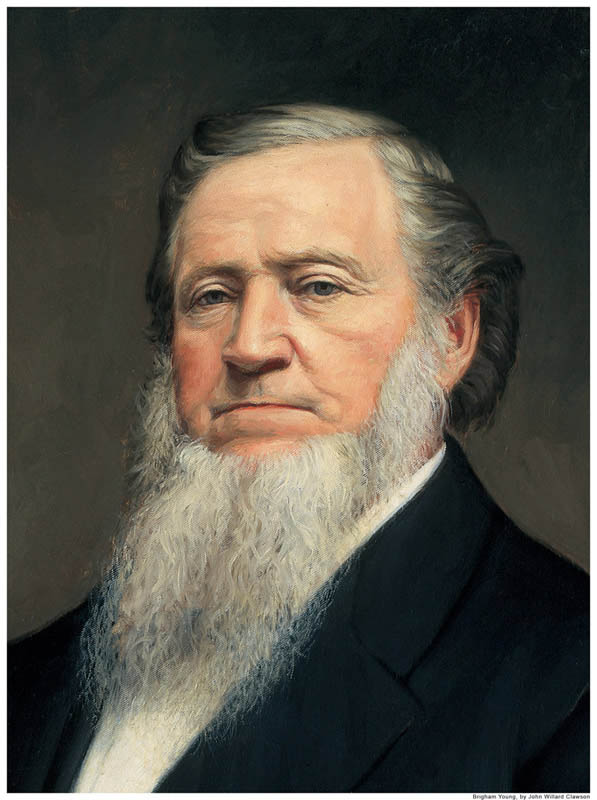Utah War
- Return to general Mormon history article.
- Return to previous time period.
The Utah War
The Mormons settled in Utah beginning in 1847, after mobs murdered the Prophet Joseph Smith and expelled the Mormon Church from Illinois. As they settled in Utah, the desert territory began to blossom. For nearly a decade the Mormons in Utah had relative peace and were free to practice their religion as they saw fit. Beginning in 1856, the Mormon Reformation, which was really just a renewed call for Mormons to live their faith, began. This was to call the Mormons out of spiritual laxity after a trying decade of being mobbed, driven, and suffering the physical trials of starting over in Utah. In 1857, their isolation ended.James Buchanan was the last antebellum President of the United States. A Democrat, his party was under intense pressure from the newly formed Republican party, which had campaigned strongly in 1856 on a platform opposed to "those twin relics of barbarism--polygamy and slavery." Slavery was not only legal, but a significant economic factor in fifteen states at the time; polygamy, practiced largely by the Mormon Church in far-off Utah territory, made a much softer target. Thus, it posed an inviting safety valve for the political pressure.
In the meantime, some federal appointees to territorial offices in Utah had turned out to be either incompetent or corrupt, or both. When the worst offenders were expelled from the territory and told that they were not wanted, a group of them formed a committee and accused the Mormons of rebelling against the authority of the United States. This gave Buchanan the pretext he needed. He removed Brigham Young as governor, appointed Alfred Cumming in his stead, and ordered five thousand troops to accompany him to the territory, under the command of Colonel Albert Sidney Johnston.
In making this move, Buchanan, either by mistake or by design, neglected to notify the incumbent governor, Brigham Young, that he had been replaced. (The fact that the mail routes to Utah were ordered closed strongly suggests that Buchanan intended to keep Young in the dark.) The first Young heard of this event was when two Mormons, O. Porter Rockwell and Abraham O. Smoot, reported to him of what they had learned during a mail run to the east. This was on July 23, 1857, almost ten years to the day since the Mormons had arrived in Utah. The army was already on the move.
Young had experienced the expulsion of the Saints from Missouri and Nauvoo, and was determined that they should not be driven from their homes again. Adopting the view that a military force of undeclared intentions is by default hostile, he made preparations to defend the territory against invasion. The territorial militia, which still bore the name of "The Nauvoo Legion," under the command of Daniel H. Wells and Lot Smith, began a campaign that avoided direct military confrontation, but operated on the army's supply trains and communications. This had the effect of crippling the army's ability to carry out offensive operations, but avoided bloodshed, which the Mormon authorities were at all times anxious to do. In this they were mostly successful, but for the single tragic exception of the Mountain Meadows massacre— panicked Mormon settlers and Piute Indians attacked a wagon train carrying Missouri and Arkansas settlers heading for California out of the mistaken belief that these were either connected to the invading army, or were threatening the Mormon settlers. Attempts by Brigham Young to stop the massacre came too late. (See also the Wikipedia entry.)
In April of 1858, after meeting with Cumming and obtaining assurances that the troops would not be permitted to harass Mormon settlers, Young resigned as governor, and within a few weeks the army was allowed to enter the Salt Lake Valley, and settle at Camp Floyd. Most of Salt Lake City had been abandoned for fear of the army, and most Mormons had fled to Provo, just south of Salt Lake, for refuge. Johnston's Army entered a deserted city. War was avoided as the army realized there was no rebellion. For the next several years, the Federal Government, distracted by the Civil War, largely left the Mormons alone and the Mormon Church was able to continue its growth and missionary work. Missionaries at this point began preaching in the South Pacific, New Zealand, and Europe.
- Proceed to next time period.
